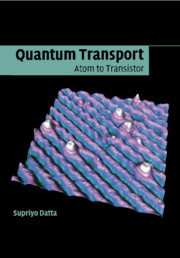Book contents
- Frontmatter
- Contents
- Preface
- Acknowledgements
- List of symbols
- 1 Prologue: an atomistic view of electrical resistance
- 2 Schrödinger equation
- 3 Self-consistent field
- 4 Basis functions
- 5 Bandstructure
- 6 Subbands
- 7 Capacitance
- 8 Level broadening
- 9 Coherent transport
- 10 Non-coherent transport
- 11 Atom to transistor
- 12 Epilogue
- Appendix: advanced formalism
- MATLAB codes used to generate text figures
- Further reading
- References
- Index
3 - Self-consistent field
Published online by Cambridge University Press: 05 June 2012
- Frontmatter
- Contents
- Preface
- Acknowledgements
- List of symbols
- 1 Prologue: an atomistic view of electrical resistance
- 2 Schrödinger equation
- 3 Self-consistent field
- 4 Basis functions
- 5 Bandstructure
- 6 Subbands
- 7 Capacitance
- 8 Level broadening
- 9 Coherent transport
- 10 Non-coherent transport
- 11 Atom to transistor
- 12 Epilogue
- Appendix: advanced formalism
- MATLAB codes used to generate text figures
- Further reading
- References
- Index
Summary
As we move from the hydrogen atom (one electron only) to multi-electron atoms, we are immediately faced with the issue of electron–electron interactions, which is at the heart of almost all the unsolved problems in our field. In this chapter I will explain (1) the self-consistent field (SCF) procedure (Section 3.1), which provides an approximate way to include electron–electron interactions into the Schrödinger equation, (2) the interpretation of the energy levels obtained from this so-called “one-electron” Schrödinger equation (Section 3.2), and (3) the energetic considerations underlying the process by which atoms “bond” to form molecules (Section 3.3). Finally, a supplementary section elaborates on the concepts of Section 3.2 for interested readers (Section 3.4).
The self-consistent field (SCF) procedure
One of the first successes of quantum theory after the interpretation of the hydrogen atom was to explain the periodic table of atoms by combining the energy levels obtained from the Schrödinger equation with the Pauli exclusion principle requiring that each level be occupied by no more than one electron. The energy eigenvalues of the Schrödinger equation for each value of l starting from l = 0 (see Eq. (2.3.8)) are numbered with integer values of n starting from n = l + 1. For any (n, l) there are (2l + 1) levels with distinct angular wavefunctions (labeled with another index m), all of which have the same energy.
- Type
- Chapter
- Information
- Quantum TransportAtom to Transistor, pp. 51 - 80Publisher: Cambridge University PressPrint publication year: 2005



